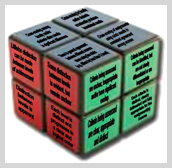collaboration
Rubrics and Assessment
18/Feb/2011 10:22 PM

The common thread that runs through all three articles is that the greatest learning takes place within the confines of shared experiences, collaborating with other people, and learning from each other. It is our job as online instructors to design the best course possible which includes higher reaching goals and objectives, complex thinking activities, self-analysis, and social interaction. We then facilitate students to reach higher levels of learning through coaching, community, and collaboration.
After reviewing the objectives and activities of my final project on Differentiated Instruction in context of the readings, I have included the aims of constructivist learning in my course. However, I realized that I was missing the collaborative piece. I went back to my plan and modified some of the activities to be more interactive and collaborative.
I had a revelation while working on the rubrics for the assessments in my final project. I came to the conclusion that analytical rubrics had the potential to keep students from doing their absolute best and performing with the highest achievement. Many students will “settle” for second best because it is “good enough” for them or they might think it’s too difficult to attain the highest proficiency level. Rick Wormeli in his book, “Fair Isn’t Always Equal: Assessing & Grading in the Differentiated Classroom” supports this idea. To overcome this limitation of analytical rubrics, I created a rubric with three proficiency levels, Exceeds Expectations, Meets Expectation, and Needs Revision. With this system, I could set the criteria very high for the Meets Expectations and reward those who would go above and beyond. At the same time, students who didn’t meet the expectation would have to revise their product until it did. I was assured that every student achieve the objective by meeting the expectation.
While this was an improvement, it still had the potential for students to only meet the expectation. Wormeli presents a different analytical rubric by which only the criteria for a “Standard of Excellence” is specifically spelled out. Students only see the “above and beyond” and work towards it. I’ve decided that I will use this style of rubric for my final project.
Comments
Assessment Toolbox
04/Feb/2011 05:08 PM

I worked with Albana and Tania on the Assessment Toolbox midterm project. I think we used technology well, especially using Skype for conferencing and instant messages. We mostly worked independently on our assigned components of the project and e-mailed our tool descriptions to each other. I assembled all of the documents into the web site. I chose to write about Google Apps as a collaboration and assessment tool. Did you notice I mentioned we e-mailed our documents to each other? Isn’t it ironic that I researched how to use Google Apps to work collaboratively in a new way and we worked together the old way!
We’ve spent a good amount of time in class reading about and discussing how to write a good learning objective. Last week, we created a concept map with sample objectives. This week, a component of the midterm project was to write at least one learning objective connected to the use of the assessment tool. On the message board we even discussed how to effectively convert learning objectives for an online course. I think a discussion about standards and benchmarks, a key component of learning objectives, was left out. National, state, and local standards define the knowledge and skills students are expected to know at each grade level. The benchmarks determine the level to which a standard must be obtained to be proficient.
Standards and benchmarks are used to guide instruction so that content gaps and overlaps do not occur. A teacher needs to create his or her learning objectives so that the expected standards and benchmarks are met. By using standards and benchmarks, most of the work in creating an objective is already done. This frees up the teacher to be more creative in planning how the objectives will be met. For future Assessment in eLearning classes, I think it would be beneficial if a discussion about standards and benchmarks was held before students begin to write objectives.